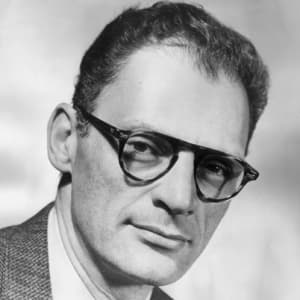Thoughts from Arthur Miller -
"The Crucible," a dramatization of the 1692 Salem witch trials, was written as an allegory for the "witch-hunt" atmosphere that pervaded America when Joseph McCarthy, a Republican representative from Wisconsin, led the nation on a search for communists in the American government. Miller said the search "paralyzed the nation. Suffice it to say, it was a time of great--no doubt unprecedented--fear."
(from Miller Recounts McCarthy Era, Origins of "The Crucible" by Kevin E. Meyers, in The Harvard Crimson, May 12, 1999.)
"It would probably never have occurred to me to write a play about the Salem witch trials of 1692 had I not seen some astonishing correspondences with that calamity in the America of the late 40s and early 50s. My basic need was to respond to a phenomenon which, with only small exaggeration, one could say paralyzed a whole generation and in a short time dried up the habits of trust and toleration in public discourse." —Arthur Miller
 Arthur Miller (1915-2005) was born in New York City and studied at the University of Michigan. His plays include THE MAN WHO HAD ALL THE LUCK (1944), ALL MY SONS (1947), DEATH OF A SALESMAN (1949), THE CRUCIBLE (1953), A VIEW FROM THE BRIDGE and A MEMORY OF TWO MONDAYS (1955), AFTER THE FALL (1964), INCIDENT AT VICHY (1964), THE PRICE (1968), THE CREATION OF THE WORLD AND OTHER BUSINESS (1972), THE ARCHBISHOP'S CEILING (1977), THE AMERICAN CLOCK (1980) AND PLAYING FOR TIME. Later plays include THE RIDE DOWN MT. MORGAN (1991), THE LAST YANKEE (1993), BROKEN GLASS (1994), MR. PETERS’ CONNECTIONS (1998), RESURRECTION BLUES (2002), and FINISHING THE PICTURE (2004). Other works include “Focus,” a novel (1945), “The Misfits,” a screenplay (1960), and the texts for “In Russia” (1969), “In the Country” (1977), and “Chinese Encounters” (1979), three books in collaboration with his wife, photographer Inge Morath. Memoirs include “Salesman in Beijing” (1984) and “Timebends,” an autobiography (1988). He twice won the New York Drama Critics Circle Award, received two Emmy awards and three Tony Awards for his plays, as well as a Tony Award for Lifetime Achievement. He also won an Obie award, a BBC Best Play Award, the George Foster Peabody Award, a Gold Medal for Drama from the National Institute of Arts and Letters, the Literary Lion Award from the New York Public Library, the John F. Kennedy Lifetime Achievement Award, and the Algur Meadows Award. He was named Jefferson Lecturer for the National Endowment for the Humanities in 2001. He received honorary degrees from Oxford University and Harvard University and was awarded the Prix Moliere of the French theatre, the Dorothy and Lillian Gish Lifetime Achievement Award, and the Pulitzer Prize.
Arthur Miller (1915-2005) was born in New York City and studied at the University of Michigan. His plays include THE MAN WHO HAD ALL THE LUCK (1944), ALL MY SONS (1947), DEATH OF A SALESMAN (1949), THE CRUCIBLE (1953), A VIEW FROM THE BRIDGE and A MEMORY OF TWO MONDAYS (1955), AFTER THE FALL (1964), INCIDENT AT VICHY (1964), THE PRICE (1968), THE CREATION OF THE WORLD AND OTHER BUSINESS (1972), THE ARCHBISHOP'S CEILING (1977), THE AMERICAN CLOCK (1980) AND PLAYING FOR TIME. Later plays include THE RIDE DOWN MT. MORGAN (1991), THE LAST YANKEE (1993), BROKEN GLASS (1994), MR. PETERS’ CONNECTIONS (1998), RESURRECTION BLUES (2002), and FINISHING THE PICTURE (2004). Other works include “Focus,” a novel (1945), “The Misfits,” a screenplay (1960), and the texts for “In Russia” (1969), “In the Country” (1977), and “Chinese Encounters” (1979), three books in collaboration with his wife, photographer Inge Morath. Memoirs include “Salesman in Beijing” (1984) and “Timebends,” an autobiography (1988). He twice won the New York Drama Critics Circle Award, received two Emmy awards and three Tony Awards for his plays, as well as a Tony Award for Lifetime Achievement. He also won an Obie award, a BBC Best Play Award, the George Foster Peabody Award, a Gold Medal for Drama from the National Institute of Arts and Letters, the Literary Lion Award from the New York Public Library, the John F. Kennedy Lifetime Achievement Award, and the Algur Meadows Award. He was named Jefferson Lecturer for the National Endowment for the Humanities in 2001. He received honorary degrees from Oxford University and Harvard University and was awarded the Prix Moliere of the French theatre, the Dorothy and Lillian Gish Lifetime Achievement Award, and the Pulitzer Prize.
Page 3 of 7